词汇学4-词的构成
- 格式:ppt
- 大小:135.00 KB
- 文档页数:22
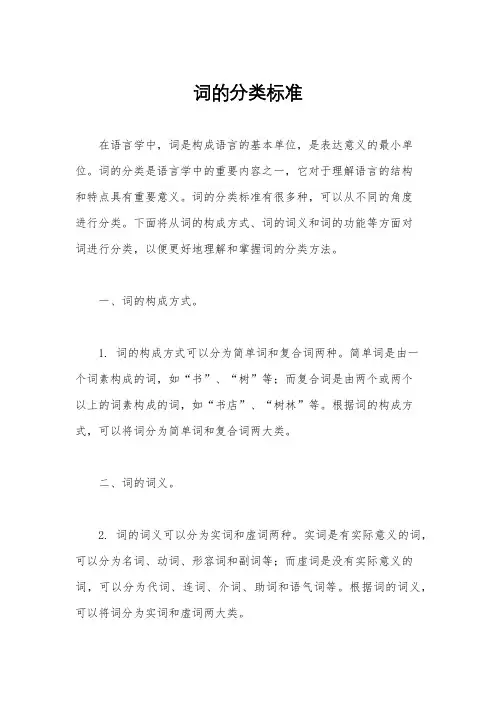
词的分类标准
在语言学中,词是构成语言的基本单位,是表达意义的最小单位。
词的分类是语言学中的重要内容之一,它对于理解语言的结构
和特点具有重要意义。
词的分类标准有很多种,可以从不同的角度
进行分类。
下面将从词的构成方式、词的词义和词的功能等方面对
词进行分类,以便更好地理解和掌握词的分类方法。
一、词的构成方式。
1. 词的构成方式可以分为简单词和复合词两种。
简单词是由一
个词素构成的词,如“书”、“树”等;而复合词是由两个或两个
以上的词素构成的词,如“书店”、“树林”等。
根据词的构成方式,可以将词分为简单词和复合词两大类。
二、词的词义。
2. 词的词义可以分为实词和虚词两种。
实词是有实际意义的词,可以分为名词、动词、形容词和副词等;而虚词是没有实际意义的词,可以分为代词、连词、介词、助词和语气词等。
根据词的词义,可以将词分为实词和虚词两大类。
三、词的功能。
3. 词的功能可以分为实词和虚词两种。
实词是有实际意义的词,可以分为名词、动词、形容词和副词等;而虚词是没有实际意义的词,可以分为代词、连词、介词、助词和语气词等。
根据词的功能,可以将词分为实词和虚词两大类。
四、总结。
综上所述,词的分类标准主要包括词的构成方式、词的词义和
词的功能等方面。
通过对词进行分类,可以更好地理解和掌握词的
特点和结构,从而更好地理解和运用语言。
因此,对词的分类标准
进行深入研究和探讨,对于提高语言能力和语言水平具有重要意义。
希望本文所述内容能够对您有所帮助,谢谢阅读!。

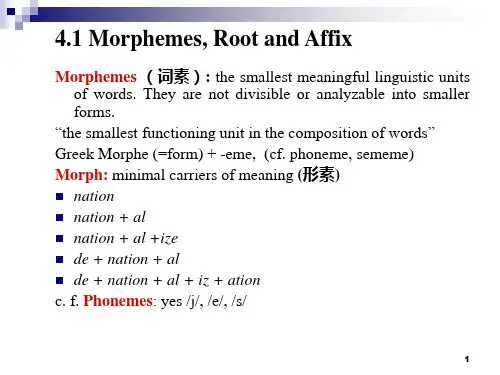
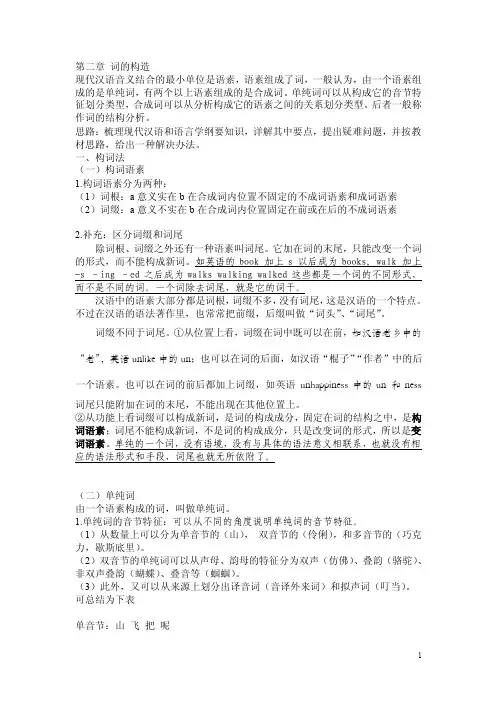
第二章词的构造现代汉语音义结合的最小单位是语素,语素组成了词,一般认为,由一个语素组成的是单纯词,有两个以上语素组成的是合成词。
单纯词可以从构成它的音节特征划分类型,合成词可以从分析构成它的语素之间的关系划分类型。
后者一般称作词的结构分析。
思路:梳理现代汉语和语言学纲要知识,详解其中要点,提出疑难问题,并按教材思路,给出一种解决办法。
一、构词法(一)构词语素1.构词语素分为两种:(1)词根:a意义实在b在合成词内位置不固定的不成词语素和成词语素(2)词缀:a意义不实在b在合成词内位置固定在前或在后的不成词语素2.补充:区分词缀和词尾除词根、词缀之外还有一种语素叫词尾。
它加在词的末尾,只能改变一个词的形式,而不能构成新词。
如英语的book 加上s 以后成为books, walk 加上-s –ing –ed之后成为walks walking walked这些都是一个词的不同形式,而不是不同的词。
一个词除去词尾,就是它的词干。
汉语中的语素大部分都是词根,词缀不多,没有词尾,这是汉语的一个特点。
不过在汉语的语法著作里,也常常把前缀,后缀叫做“词头”、“词尾”。
词缀不同于词尾。
①从位置上看,词缀在词中既可以在前,如汉语老乡中的“老”,英语unlike中的un;也可以在词的后面,如汉语“棍子”“作者”中的后一个语素。
也可以在词的前后都加上词缀,如英语unhappiness中的un 和ness词尾只能附加在词的末尾,不能出现在其他位置上。
②从功能上看词缀可以构成新词,是词的构成成分,固定在词的结构之中,是构词语素;词尾不能构成新词,不是词的构成成分,只是改变词的形式,所以是变词语素。
单纯的一个词,没有语境,没有与具体的语法意义相联系,也就没有相应的语法形式和手段,词尾也就无所依附了。
(二)单纯词由一个语素构成的词,叫做单纯词。
1.单纯词的音节特征:可以从不同的角度说明单纯词的音节特征。
(1)从数量上可以分为单音节的(山),双音节的(伶俐),和多音节的(巧克力,歇斯底里)。
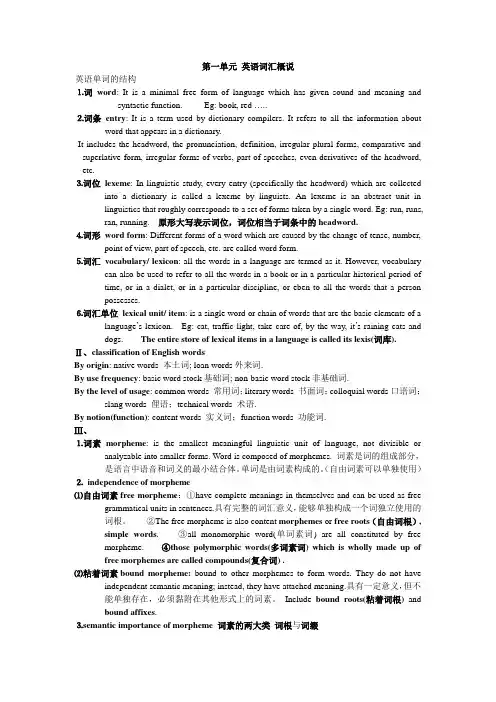
第一单元英语词汇概说英语单词的结构⒈词word: It is a minimal free form of language which has given sound and meaning andsyntactic function. Eg: book, red …..⒉词条entry: It is a term used by dictionary compilers. It refers to all the information aboutword that appears in a dictionary.It includes the headword, the pronunciation, definition, irregular plural forms, comparative and superlative form, irregular forms of verbs, part of speeches, even derivatives of the headword, etc.⒊词位lexeme: In linguistic study, every entry (specifically the headword) which are collectedinto a dictionary is called a lexeme by linguists. An lexeme is an abstract unit in linguistics that roughly corresponds to a set of forms taken by a single word. Eg: run, runs, ran, running. 原形大写表示词位,词位相当于词条中的headword.⒋词形word form: Different forms of a word which are caused by the change of tense, number,point of view, part of speech, etc. are called word form.⒌词汇vocabulary/ lexicon: all the words in a language are termed as it. However, vocabularycan also be used to refer to all the words in a book or in a particular historical period of time, or in a dialet, or in a particular discipline, or eben to all the words that a person possesses.⒍词汇单位lexical unit/ item: is a single word or chain of words that are the basic elements of alanguage’s lexicon. Eg: cat, traffic light, take care of, by-the-way, it’s raining cats and dogs. The entire store of lexical items in a language is called its lexis(词库).Ⅱ、classification of English wordsBy origin: native words 本土词; loan words外来词.By use frequency: basic word stock基础词; non-basic word stock非基础词.By the level of usage: common words 常用词;literary words 书面词;colloquial words口语词;slang words 俚语;technical words 术语.By notion(function): content words 实义词;function words 功能词.Ⅲ、⒈词素morpheme: is the smallest meaningful linguistic unit of language, not divisible oranalyzable into smaller forms. Word is composed of morphemes. 词素是词的组成部分,是语言中语音和词义的最小结合体。

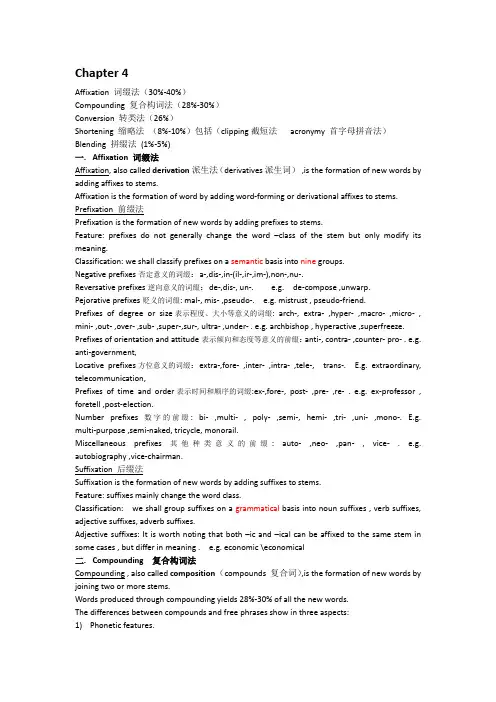
Chapter 4Affixation 词缀法(30%-40%)Compounding 复合构词法(28%-30%)Conversion 转类法(26%)Shortening 缩略法(8%-10%)包括(clipping截短法acronymy 首字母拼音法)Blending 拼缀法(1%-5%)一.Affixation 词缀法Affixation, also called derivation派生法(derivatives派生词),is the formation of new words by adding affixes to stems.Affixation is the formation of word by adding word-forming or derivational affixes to stems. Prefixation 前缀法Prefixation is the formation of new words by adding prefixes to stems.Feature: prefixes do not generally change the word –class of the stem but only modify its meaning.Classification: we shall classify prefixes on a semantic basis into nine groups.Negative prefixes否定意义的词缀:a-,dis-,in-(il-,ir-,im-),non-,nu-.Reversative prefixes逆向意义的词缀:de-,dis-, un-. e.g. de-compose ,unwarp.Pejorative prefixes贬义的词缀: mal-, mis- ,pseudo-. e.g. mistrust , pseudo-friend.Prefixes of degree or size表示程度、大小等意义的词缀: arch-, extra- ,hyper- ,macro- ,micro- , mini- ,out- ,over- ,sub- ,super-,sur-, ultra- ,under- . e.g. archbishop , hyperactive ,superfreeze. Prefixes of orientation and attitude表示倾向和态度等意义的前缀:anti-, contra- ,counter- pro- . e.g. anti-government,Locative prefixes方位意义的词缀:extra-,fore- ,inter- ,intra- ,tele-, trans-. E.g. extraordinary, telecommunication,Prefixes of time and order表示时间和顺序的词缀:ex-,fore-, post- ,pre- ,re- . e.g. ex-professor , foretell ,post-election.Number prefixes数字的前缀: bi- ,multi- , poly- ,semi-, hemi- ,tri- ,uni- ,mono-. E.g. multi-purpose ,semi-naked, tricycle, monorail.Miscellaneous prefixes其他种类意义的前缀: auto- ,neo- ,pan- , vice- . e.g. autobiography ,vice-chairman.Suffixation 后缀法Suffixation is the formation of new words by adding suffixes to stems.Feature: suffixes mainly change the word class.Classification: we shall group suffixes on a grammatical basis into noun suffixes , verb suffixes, adjective suffixes, adverb suffixes.Adjective suffixes: It is worth noting that both –ic and –ical can be affixed to the same stem in some cases , but differ in meaning . e.g. economic \economical二.Compounding 复合构词法Compounding , also called composition(compounds 复合词),is the formation of new words by joining two or more stems.Words produced through compounding yields 28%-30% of all the new words.The differences between compounds and free phrases show in three aspects:1)Phonetic features.2)Semantic features.3)Grammatical features.Formation of compounds1)Noun compoundse.g. Sit-in ,stockholder , up-bringing2)Adjective compoundse.g. law-abiding , record-breaking ,town-bred , four-leg.3)Verb compoundsThe limited number of verb compounds are created either through conversion or backformation. Verb compounds in the way of back-formation are formed mainly by dropping the suffixes:-er, -ing, -ion , etc.三.Conversion 转类法Conversion is the formation of new words by converting words of one class to another class. Conversion is a method of turning words of one part of speech to those of a different part of speech.1.An alternative for conversion is functional shift.2.The derivational process , in which an item is converted to a new word class without theaddition of an affix , is called zero-derivation .3.Words produced by conversion are primarily nouns , adjectives ,and verbs.The most productive conversion is the conversion that takes place between nouns and verbs.4.Full conversion and partial conversion are concerned with adjectives when converted tonouns.1)Full conversion: A noun fully converted from an adjective has all the characteristics ofnouns . It can take an indefinite article or –(e)s to indicate singular or plural number.2)partial conversion: nouns partially converted from adjectives do not possess all thequalities a noun does. They must be used together with definite articles.3)Such words as “the poor ”,”the richer ”,”the most corrupt” are all examples of partial. 5.The conversion of two syllable nouns into verbs involves a change of stress.双音节的名词转化成动词会有重音的变化。
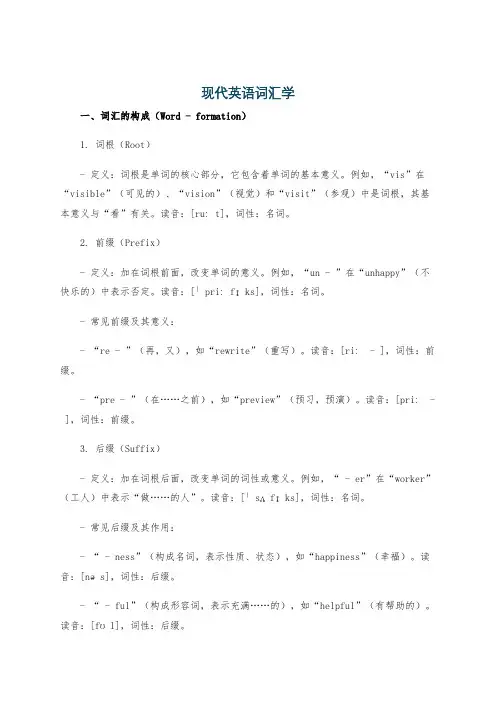
现代英语词汇学一、词汇的构成(Word - formation)1. 词根(Root)- 定义:词根是单词的核心部分,它包含着单词的基本意义。
例如,“vis”在“visible”(可见的)、“vision”(视觉)和“visit”(参观)中是词根,其基本意义与“看”有关。
读音:[ruːt],词性:名词。
2. 前缀(Prefix)- 定义:加在词根前面,改变单词的意义。
例如,“un - ”在“unhappy”(不快乐的)中表示否定。
读音:[ˈpriːfɪks],词性:名词。
- 常见前缀及其意义:- “re - ”(再,又),如“rewrite”(重写)。
读音:[riː - ],词性:前缀。
- “pre - ”(在……之前),如“preview”(预习,预演)。
读音:[priː - ],词性:前缀。
3. 后缀(Suffix)- 定义:加在词根后面,改变单词的词性或意义。
例如,“ - er”在“worker”(工人)中表示“做……的人”。
读音:[ˈsʌfɪks],词性:名词。
- 常见后缀及其作用:- “ - ness”(构成名词,表示性质、状态),如“happiness”(幸福)。
读音:[nəs],词性:后缀。
- “ - ful”(构成形容词,表示充满……的),如“helpful”(有帮助的)。
读音:[fʊl],词性:后缀。
二、词性(Parts of Speech)1. 名词(Noun)- 定义:表示人、事物、地点、抽象概念等。
例如,“book”(书)、“city”(城市)、“love”(爱)。
读音:[naʊn],词性:名词。
- 名词的分类:- 可数名词(Countable Noun),如“apple”(苹果),有单复数形式。
- 不可数名词(Uncountable Noun),如“water”(水),一般没有复数形式。
2. 动词(Verb)- 定义:表示动作或状态。
例如,“run”(跑)、“be”(是)。

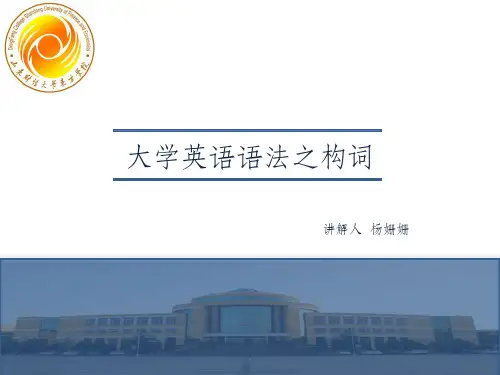
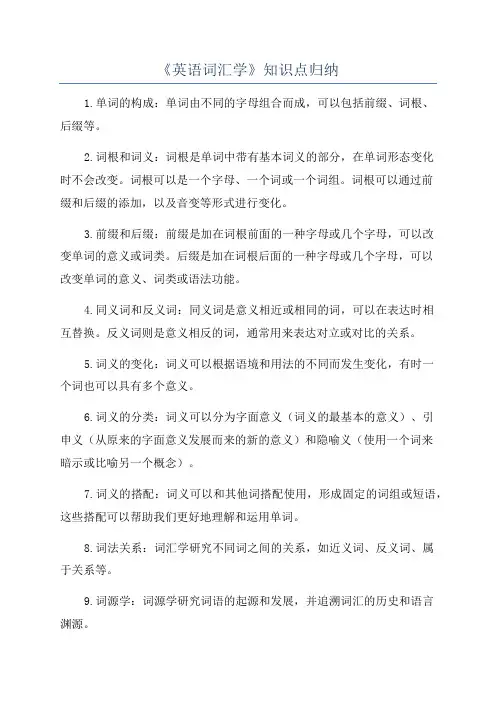
《英语词汇学》知识点归纳
1.单词的构成:单词由不同的字母组合而成,可以包括前缀、词根、
后缀等。
2.词根和词义:词根是单词中带有基本词义的部分,在单词形态变化
时不会改变。
词根可以是一个字母、一个词或一个词组。
词根可以通过前
缀和后缀的添加,以及音变等形式进行变化。
3.前缀和后缀:前缀是加在词根前面的一种字母或几个字母,可以改
变单词的意义或词类。
后缀是加在词根后面的一种字母或几个字母,可以
改变单词的意义、词类或语法功能。
4.同义词和反义词:同义词是意义相近或相同的词,可以在表达时相
互替换。
反义词则是意义相反的词,通常用来表达对立或对比的关系。
5.词义的变化:词义可以根据语境和用法的不同而发生变化,有时一
个词也可以具有多个意义。
6.词义的分类:词义可以分为字面意义(词义的最基本的意义)、引
申义(从原来的字面意义发展而来的新的意义)和隐喻义(使用一个词来
暗示或比喻另一个概念)。
7.词义的搭配:词义可以和其他词搭配使用,形成固定的词组或短语,这些搭配可以帮助我们更好地理解和运用单词。
8.词法关系:词汇学研究不同词之间的关系,如近义词、反义词、属
于关系等。
9.词源学:词源学研究词语的起源和发展,并追溯词汇的历史和语言
渊源。
10.词汇扩充:词汇学研究如何通过学习和运用词汇扩充词汇量,如学习词根、前缀和后缀的意义和用法,以及拆解和分析复杂单词的方法。
语言学知识点语言是人类最重要的交流工具,它不仅反映了人们思维的方式,还承载着文化、历史和社会的信息。
语言学是研究语言的科学,涵盖了词汇、语法、语音等多个方面。
本文将介绍一些语言学的基本知识点,帮助读者更好地理解和使用语言。
一、词汇学词汇学是研究词汇的学科,主要研究词的构成、分类、意义和用法等。
在语言中,词是最基本的语言单位,是人们进行意义表达的基础。
1. 词的构成:词由一个或多个音节组成,音节是语音的最小单位。
一个词可以由一个音节组成(如“日”),也可以由多个音节组成(如“手机”)。
2. 词的分类:根据词的性质和功能,可以将词分为不同的类别,如名词、动词、形容词、副词等。
名词用来表示事物,动词用来表示动作或状态,形容词用来描述事物的特征,副词用来修饰动词、形容词或其他副词。
3. 词的意义和用法:词的意义是指词所代表的概念或事物,词的用法是指词在语境中的具体应用。
词的意义和用法与词的上下文有关,同一个词在不同的语境中可能有不同的意义和用法。
二、语法学语法学是研究句子结构和句子之间关系的学科,主要研究句子的组成、句子成分的功能和语序等。
语法规定了语言的结构和组织方式,是语言表达的重要规范。
1. 句子结构:句子由词组合而成,词之间有一定的组织结构。
按照语法规则,句子可以分为主谓结构、主系表结构、主谓宾结构等不同的句子结构。
2. 句子成分:句子由一个或多个句子成分组成,句子成分包括主语、谓语、宾语、定语、状语等。
主语通常是进行动作的执行者,谓语表示动作或状态,宾语是动作的承受者或影响对象,定语和状语用来修饰名词或动词。
3. 语序:语序是指词或词组在句子中的排列顺序。
不同的语言有不同的语序规则,汉语的基本语序为主谓宾,但也可以根据需要进行灵活调整。
三、语音学语音学是研究语音的学科,主要研究语音的产生、传播和感知等。
语音是语言中最基本的声音单位,也是语言交流的基础。
1. 音素:音素是语言中最小的语音单位,用来区分词和词之间的差异。
Chapter 4Affixation 词缀法(30%-40%)Compounding 复合构词法(28%-30%)Conversion 转类法(26%)Shortening 缩略法(8%-10%)包括(clipping截短法acronymy 首字母拼音法)Blending 拼缀法(1%-5%)Affixation 词缀法Affixation, also called derivation派生法(derivatives派生词),is the formation of new words by adding affixes to stems.Affixation is the formation of word by adding word-forming or derivational affixes to stems. Prefixation 前缀法Prefixation is the formation of new words by adding prefixes to stems.Feature: prefixes do not generally change the word –class of the stem but only modify its meaning.Classification: we shall classify prefixes on a semantic basis into nine groups.Negative prefixes否定意义的词缀:a-,dis-,in-(il-,ir-,im-),non-,nu-.Reversative prefixes逆向意义的词缀:de-,dis-, un-. . de-compose ,unwarp.Pejorative prefixes贬义的词缀: mal-, mis- ,pseudo-. . mistrust , pseudo-friend.Prefixes of degree or size表示程度、大小等意义的词缀: arch-, extra- ,hyper- ,macro- ,micro- ,mini- ,out- ,over- ,sub- ,super-,sur-, ultra- ,under- . . archbishop , hyperactive ,superfreeze. Prefixes of orientation and attitude表示倾向和态度等意义的前缀:anti-, contra- ,counter- pro- . . anti-government,Locative prefixes方位意义的词缀:extra-,fore- ,inter- ,intra- ,tele-, trans-. . extraordinary, telecommunication,Prefixes of time and order表示时间和顺序的词缀:ex-,fore-, post- ,pre- ,re- . . ex-professor , foretell ,post-election.Number prefixes数字的前缀: bi- ,multi- , poly- ,semi-, hemi- ,tri- ,uni- ,mono-. .multi-purpose ,semi-naked, tricycle, monorail.Miscellaneous prefixes其他种类意义的前缀: auto- ,neo- ,pan- , vice- . .autobiography ,vice-chairman.Suffixation 后缀法Suffixation is the formation of new words by adding suffixes to stems.Feature: suffixes mainly change the word class.Classification: we shall group suffixes on a grammatical basis into noun suffixes , verb suffixes, adjective suffixes, adverb suffixes.Adjective suffixes: It is worth noting that both –ic and –ical can be affixed to the same stem in some cases , but differ in meaning . . economic \economicalCompounding 复合构词法Compounding , also called composition(compounds 复合词),is the formation of new words by joining two or more stems.Words produced through compounding yields 28%-30% of all the new words.The differences between compounds and free phrases show in three aspects:Phonetic features.Semantic features.Grammatical features.Formation of compoundsNoun compounds. Sit-in ,stockholder , up-bringingAdjective compounds. law-abiding , record-breaking ,town-bred , four-leg.Verb compoundsThe limited number of verb compounds are created either through conversion or backformation. Verb compounds in the way of back-formation are formed mainly by dropping the suffixes:-er,-ing, -ion , etc.Conversion 转类法Conversion is the formation of new words by converting words of one class to another class. Conversion is a method of turning words of one part of speech to those of a different part of speech.An alternative for conversion is functional shift.The derivational process , in which an item is converted to a new word class without the addition of an affix , is called zero-derivation .Words produced by conversion are primarily nouns , adjectives ,and verbs.The most productive conversion is the conversion that takes place between nouns and verbs. Full conversion and partial conversion are concerned with adjectives when converted to nouns. Full conversion: A noun fully converted from an adjective has all the characteristics of nouns . It can take an indefinite article or –(e)s to indicate singular or plural number.partial conversion: nouns partially converted from adjectives do not possess all the qualities a noun does. They must be used together with definite articles.Such words as “the poor ”,”the richer ”,”the most corrupt” are all examples of partial.The conversion of two syllable nouns into verbs involves a change of stress.双音节的名词转化成动词会有重音的变化。